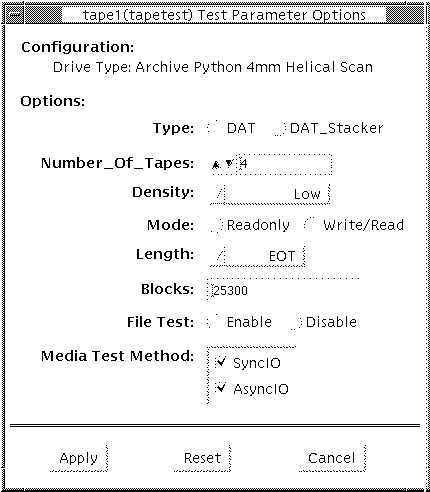Chapter 57 Tape Drive Test (tapetest)
The tapetest synchronous I/O test writes a pattern to a specified number of blocks (or, for a SCSI tape, writes to the end of the tape). The tapetest then rewinds the tape and reads and compares the data just written. The tapetest asynchronous I/O test sends a series of up to five asynchronous read/write requests to the tape drive, writing to the tape and then reading and comparing the data. The terms asynchronous and synchronous referred to here, and in the "method" field are not related to the scsi messaging terms of the same name. The tapetest file test writes four files to the tape and then reads them back, comparing the data. For tape library testing, the pass count is incremented only after all tapes in the library have been tested. The read/write algorithms fare enhanced for DLT tape by using a random data pattern (1.5:1 compression) and a more robust read compare algorithm. Some default parameters have also changed.
tapetest Test Requirements
If you have a tape drive in your system, load a blank writable tape (scratch tape) before you start SunVTS. If you fail to do this, the tapetest option may display drive type:unknown on the option menu for the tapetest.
tapetest Options
To reach the dialog box below, right-click on the test name in the System Map and select Test Parameter Options. If you do not see this test in the System Map, you might need to expand the collapsed groups, or your system may not include the device appropriate to this test. Refer to the SunVTS User's Guide for more details.
tapetest supports 4-mm, 8-mm, DLT, 1/4-inch cartridge, and 1/2-inch front-load tape drive testing. The options available for each of the tape devices differ slightly. An example of the Options dialog box for a device is shown in Figure 57-1.
The Async I/O subtest uses the asynchronous read and write feature of the Solaris tape driver to exercise tape drives. In read-only mode the test sends a maximum of four asynchronous read packets, each with a random size and a random offset, to the tape drive. The test then waits for all outstanding I/O activity to complete before issuing another round of packets. This process continues until the whole area being tested has been covered. In read-write mode, one write packet is issued for every four read packets to ensure a spot check of the write operation. The area of the tape to be tested is written to first in order for the test to work correctly. This test is only supported under the Solaris 2.6, Solaris 7, and Solaris 8 operating environments and compatible releases.
Figure 57-1 tapetet Test Parameter Options Dialog Box (4-mm Tape Drive)

Note -
This test does not immediately stop after being disabled.
Note -
Selecting non-default options can significantly increase the run time for the test.
Note -
The Options dialog box for the 1/4-inch, 1/2-inch, DLT, and 8-mm tape drives differ slightly from Figure 57-1.
Table 57-1 tapetest Options
tapetest Test Modes
The tapetest supports all three modes. It performs different test schemes on the tape device, according to the mode you select.
Table 57-2 tapetest Test Modes|
Test Mode |
Supported? |
Description |
|---|---|---|
|
Connection |
Yes |
tapetest verifies that the drive can be opened and that the drive type can be determined. If both checks are successful, or if the drive is currently busy, then the test passes. The tapetest fails if the open operation is unsuccessful for any reason other than the drive is busy. |
|
Functional (Offline) |
Yes |
tapetest checks the status, rewinds the tape, erases and retensions it. If the device is a cartridge tape, tapetest writes a pattern to nblks or eot (default), rewinds the tape, and then reads and compares of the pattern. On the other hand, if the device is busy or if no tape cartridge can be found in the drive, the test cannot run and fails. |
tapetest Command-Line Syntax
/opt/SUNWvts/bin/tapetest standard_arguments -o dev=device_name, s=block_count,d=density,m=mode,l=length,method=method,ft=enables|disables, ret=enables|disables,dat=dat_type,8mm=8mm_type,num=magazine_size, blocksize=block_size
Table 57-3 tapetest Command-Line Syntax|
Argument |
Explanation |
|---|---|
|
dev=device_name |
Specifies the device_name of the tape drive (required). |
|
s=block_count |
Specifies the number of blocks to be tested. |
|
d=density |
Specifies the density of the tape to open. |
|
m=mode |
Enables either the Write_Read or Read_Only tests. |
|
l=length |
Specifies the length of the test (EOT, Specified, Long, or Short). |
|
method=method |
Specifies the media test method (SyncI/O and or AsyncI/O) used.
Note: This option does not invoke the SCSI message "synchronous data transfer request. It is only asynchronous or synchronous in nature. |
|
ft=enables|disables |
Enables or disables the File test. |
|
ret=enables|disables |
Enable or disables tape retension. |
|
dat=dat_type |
If you are testing a digital audio tape drive, specify whether it is a regular DAT drive or a DAT stacker. The choices are DAT and DAT_Stacker. |
|
8mm=8mm_type |
If you are testing an 8-mm tape drive, specify whether it is a regular 8-mm tape drive or a tape library. The command line choices are 8mm and 8mm_Library. |
|
num=magazine_size |
If you are testing a tape library, specify the magazine size. |
|
blocksize= block_size |
This option is only available on a Tandberg QIC drive and DLT drives. Specify whether to use a 64 kbyte block transfer or a 512 byte block transfer. Use 512 bytes when testing older media in the drive. DLT supports 512 byte and 65536 byte modes |
Note -
64-bit tests are located in the sparcv9 subdirectory: /opt/SUNWvts/bin/sparcv9/testname. If a test is not present in this directory, then it may only be available as a 32-bit test. For more information refer to "32-Bit and 64-Bit Tests".
- © 2010, Oracle Corporation and/or its affiliates
